Detailed Business Environment Analysis Report: Nestle Company
VerifiedAdded on 2020/01/21
|14
|4661
|2116
Report
AI Summary
This report provides a detailed analysis of Nestle's business environment, examining various aspects that influence its operations and strategic planning. It begins by exploring different types of business organizations and their objectives, focusing on how Nestle aligns with stakeholder goals and fulfills its responsibilities. The report then delves into the economic systems, including fiscal and monetary policies, and their impact on Nestle's resource allocation and financial strategies. It also analyzes competition policies and market structures, including marketing strategies, and Nestle's responses to market forces. Furthermore, the report investigates the cultural and business environment, including the impact of international trade and global factors. Finally, it assesses the influence of the EU and its policies on Nestle's business, providing a comprehensive overview of the company's environment and its strategic responses.
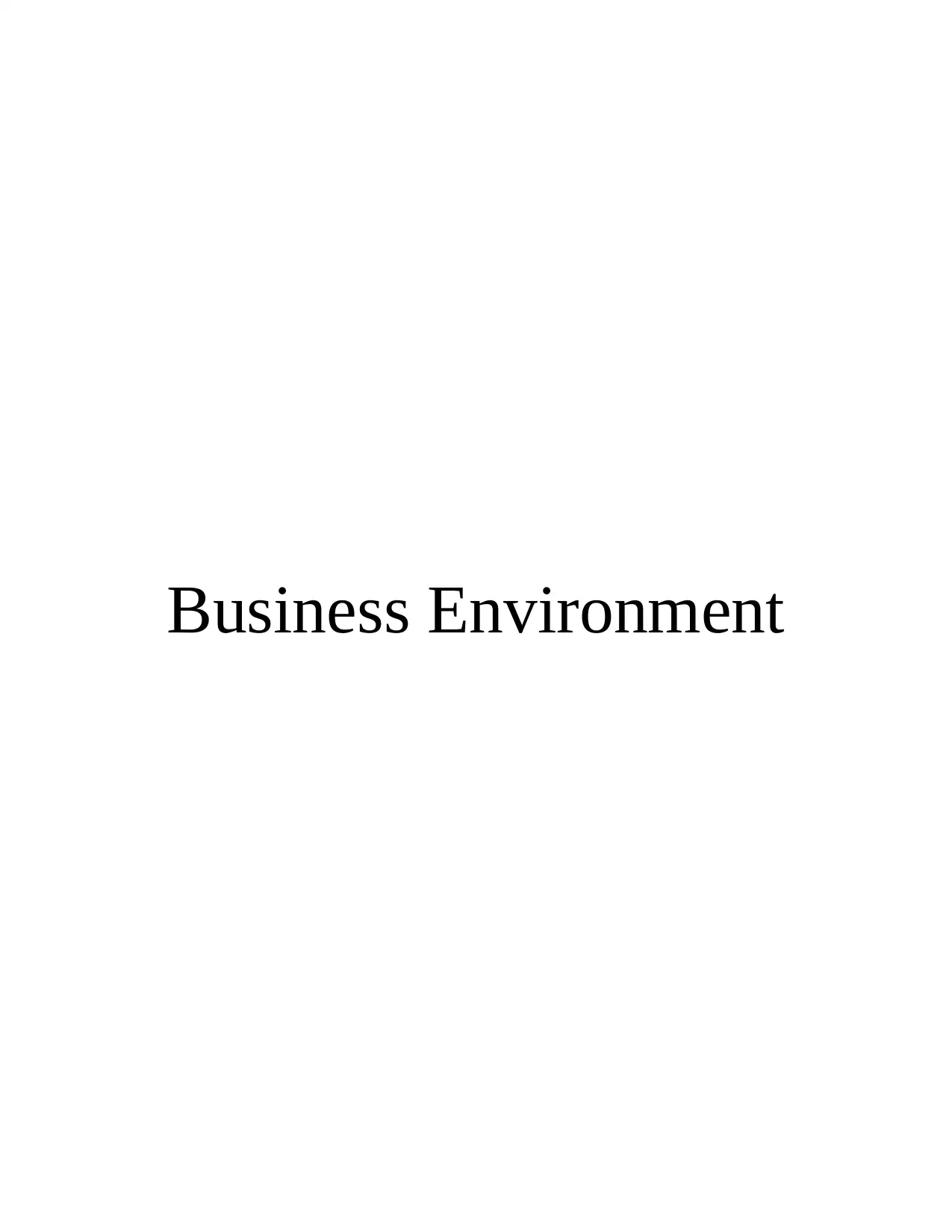
Business Environment
Paraphrase This Document
Need a fresh take? Get an instant paraphrase of this document with our AI Paraphraser
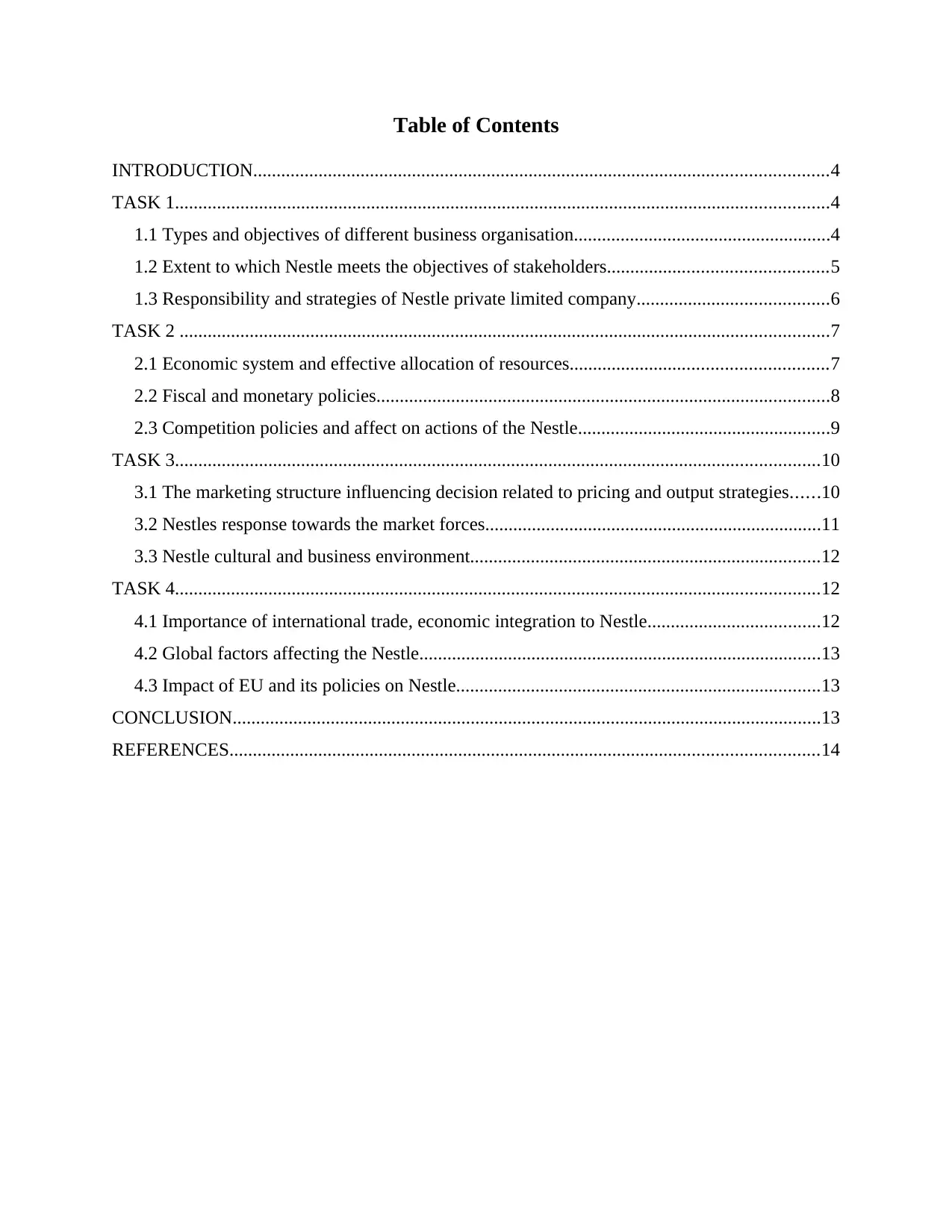
Table of Contents
INTRODUCTION...........................................................................................................................4
TASK 1............................................................................................................................................4
1.1 Types and objectives of different business organisation.......................................................4
1.2 Extent to which Nestle meets the objectives of stakeholders...............................................5
1.3 Responsibility and strategies of Nestle private limited company.........................................6
TASK 2 ...........................................................................................................................................7
2.1 Economic system and effective allocation of resources.......................................................7
2.2 Fiscal and monetary policies.................................................................................................8
2.3 Competition policies and affect on actions of the Nestle......................................................9
TASK 3..........................................................................................................................................10
3.1 The marketing structure influencing decision related to pricing and output strategies......10
3.2 Nestles response towards the market forces........................................................................11
3.3 Nestle cultural and business environment...........................................................................12
TASK 4..........................................................................................................................................12
4.1 Importance of international trade, economic integration to Nestle.....................................12
4.2 Global factors affecting the Nestle......................................................................................13
4.3 Impact of EU and its policies on Nestle..............................................................................13
CONCLUSION..............................................................................................................................13
REFERENCES..............................................................................................................................14
INTRODUCTION...........................................................................................................................4
TASK 1............................................................................................................................................4
1.1 Types and objectives of different business organisation.......................................................4
1.2 Extent to which Nestle meets the objectives of stakeholders...............................................5
1.3 Responsibility and strategies of Nestle private limited company.........................................6
TASK 2 ...........................................................................................................................................7
2.1 Economic system and effective allocation of resources.......................................................7
2.2 Fiscal and monetary policies.................................................................................................8
2.3 Competition policies and affect on actions of the Nestle......................................................9
TASK 3..........................................................................................................................................10
3.1 The marketing structure influencing decision related to pricing and output strategies......10
3.2 Nestles response towards the market forces........................................................................11
3.3 Nestle cultural and business environment...........................................................................12
TASK 4..........................................................................................................................................12
4.1 Importance of international trade, economic integration to Nestle.....................................12
4.2 Global factors affecting the Nestle......................................................................................13
4.3 Impact of EU and its policies on Nestle..............................................................................13
CONCLUSION..............................................................................................................................13
REFERENCES..............................................................................................................................14
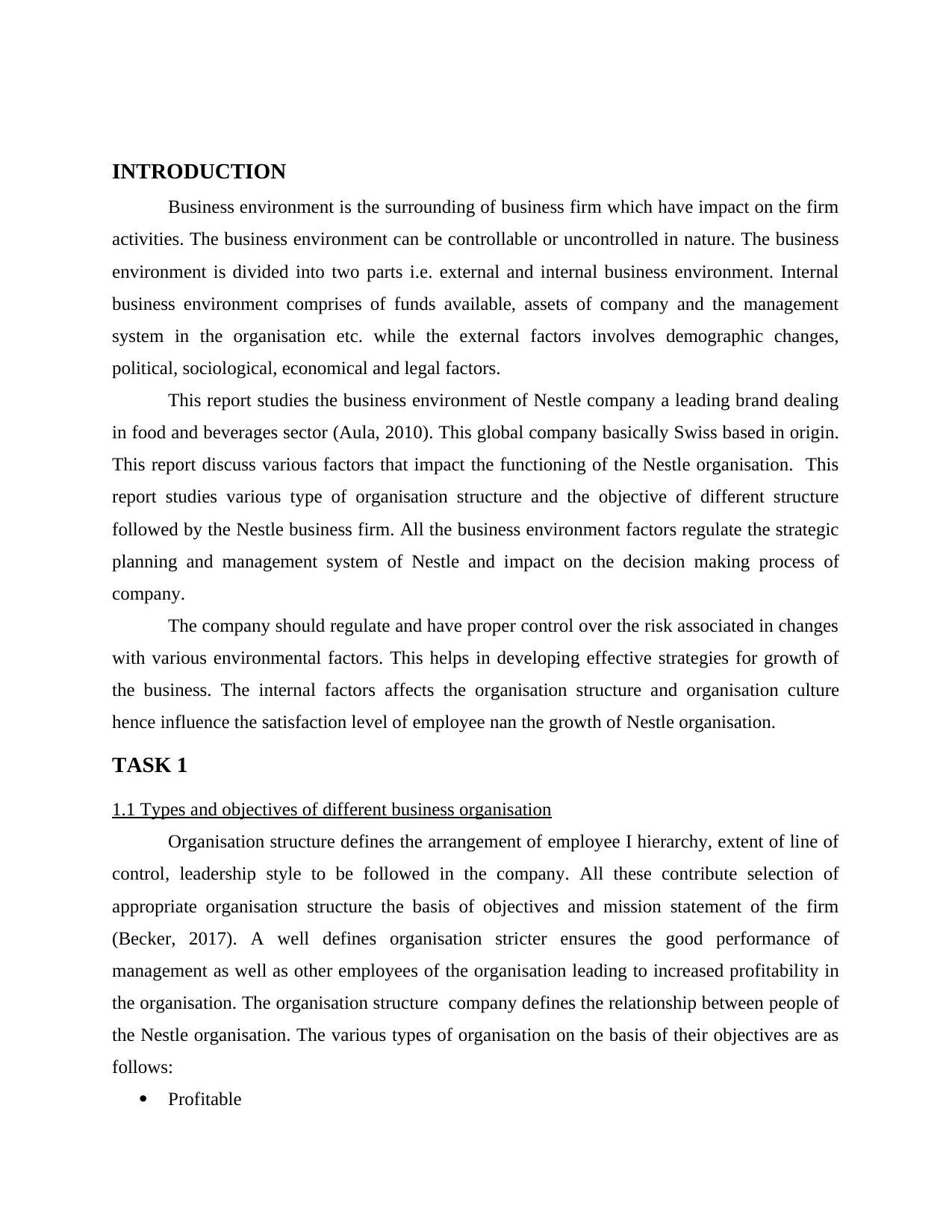
INTRODUCTION
Business environment is the surrounding of business firm which have impact on the firm
activities. The business environment can be controllable or uncontrolled in nature. The business
environment is divided into two parts i.e. external and internal business environment. Internal
business environment comprises of funds available, assets of company and the management
system in the organisation etc. while the external factors involves demographic changes,
political, sociological, economical and legal factors.
This report studies the business environment of Nestle company a leading brand dealing
in food and beverages sector (Aula, 2010). This global company basically Swiss based in origin.
This report discuss various factors that impact the functioning of the Nestle organisation. This
report studies various type of organisation structure and the objective of different structure
followed by the Nestle business firm. All the business environment factors regulate the strategic
planning and management system of Nestle and impact on the decision making process of
company.
The company should regulate and have proper control over the risk associated in changes
with various environmental factors. This helps in developing effective strategies for growth of
the business. The internal factors affects the organisation structure and organisation culture
hence influence the satisfaction level of employee nan the growth of Nestle organisation.
TASK 1
1.1 Types and objectives of different business organisation
Organisation structure defines the arrangement of employee I hierarchy, extent of line of
control, leadership style to be followed in the company. All these contribute selection of
appropriate organisation structure the basis of objectives and mission statement of the firm
(Becker, 2017). A well defines organisation stricter ensures the good performance of
management as well as other employees of the organisation leading to increased profitability in
the organisation. The organisation structure company defines the relationship between people of
the Nestle organisation. The various types of organisation on the basis of their objectives are as
follows:
Profitable
Business environment is the surrounding of business firm which have impact on the firm
activities. The business environment can be controllable or uncontrolled in nature. The business
environment is divided into two parts i.e. external and internal business environment. Internal
business environment comprises of funds available, assets of company and the management
system in the organisation etc. while the external factors involves demographic changes,
political, sociological, economical and legal factors.
This report studies the business environment of Nestle company a leading brand dealing
in food and beverages sector (Aula, 2010). This global company basically Swiss based in origin.
This report discuss various factors that impact the functioning of the Nestle organisation. This
report studies various type of organisation structure and the objective of different structure
followed by the Nestle business firm. All the business environment factors regulate the strategic
planning and management system of Nestle and impact on the decision making process of
company.
The company should regulate and have proper control over the risk associated in changes
with various environmental factors. This helps in developing effective strategies for growth of
the business. The internal factors affects the organisation structure and organisation culture
hence influence the satisfaction level of employee nan the growth of Nestle organisation.
TASK 1
1.1 Types and objectives of different business organisation
Organisation structure defines the arrangement of employee I hierarchy, extent of line of
control, leadership style to be followed in the company. All these contribute selection of
appropriate organisation structure the basis of objectives and mission statement of the firm
(Becker, 2017). A well defines organisation stricter ensures the good performance of
management as well as other employees of the organisation leading to increased profitability in
the organisation. The organisation structure company defines the relationship between people of
the Nestle organisation. The various types of organisation on the basis of their objectives are as
follows:
Profitable
⊘ This is a preview!⊘
Do you want full access?
Subscribe today to unlock all pages.

Trusted by 1+ million students worldwide
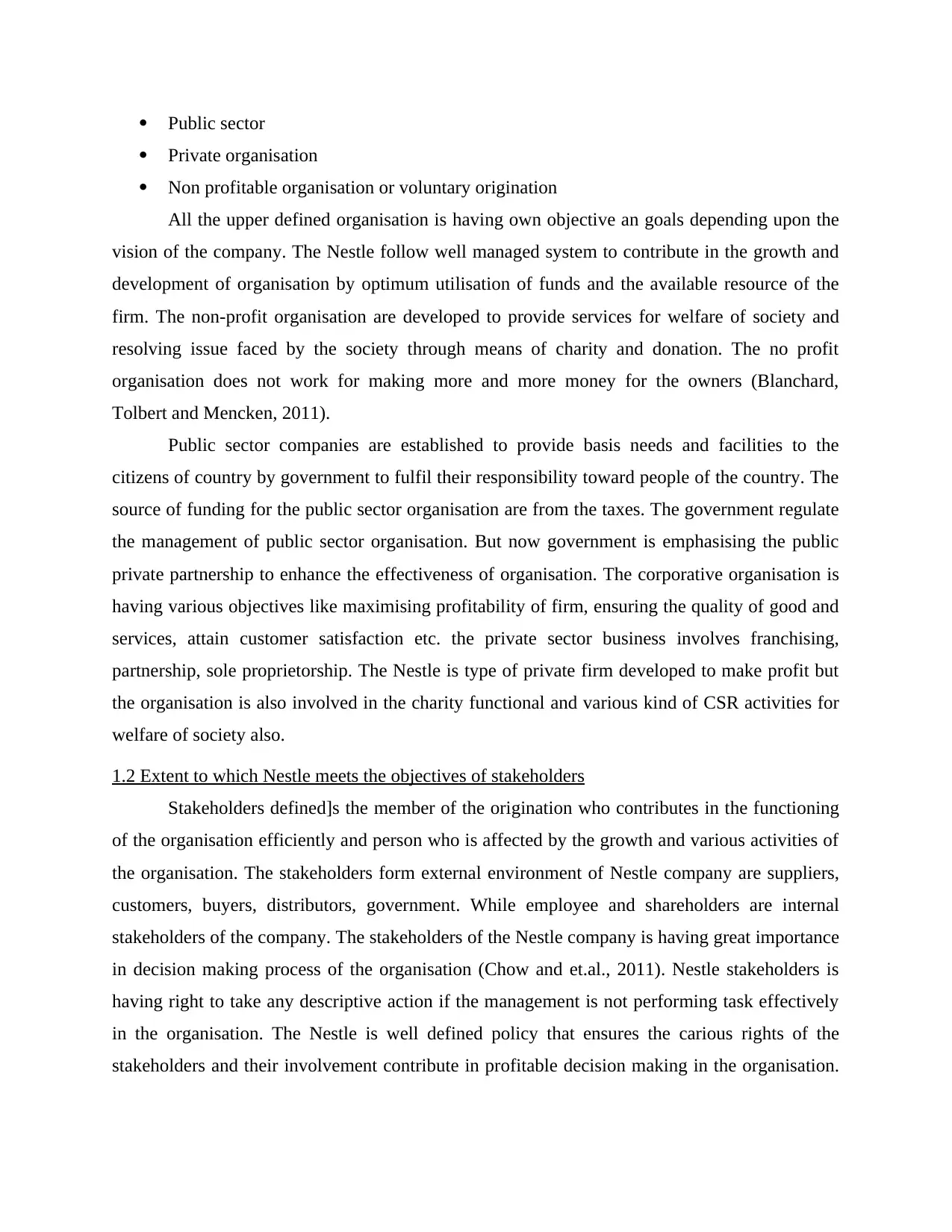
Public sector
Private organisation
Non profitable organisation or voluntary origination
All the upper defined organisation is having own objective an goals depending upon the
vision of the company. The Nestle follow well managed system to contribute in the growth and
development of organisation by optimum utilisation of funds and the available resource of the
firm. The non-profit organisation are developed to provide services for welfare of society and
resolving issue faced by the society through means of charity and donation. The no profit
organisation does not work for making more and more money for the owners (Blanchard,
Tolbert and Mencken, 2011).
Public sector companies are established to provide basis needs and facilities to the
citizens of country by government to fulfil their responsibility toward people of the country. The
source of funding for the public sector organisation are from the taxes. The government regulate
the management of public sector organisation. But now government is emphasising the public
private partnership to enhance the effectiveness of organisation. The corporative organisation is
having various objectives like maximising profitability of firm, ensuring the quality of good and
services, attain customer satisfaction etc. the private sector business involves franchising,
partnership, sole proprietorship. The Nestle is type of private firm developed to make profit but
the organisation is also involved in the charity functional and various kind of CSR activities for
welfare of society also.
1.2 Extent to which Nestle meets the objectives of stakeholders
Stakeholders defined]s the member of the origination who contributes in the functioning
of the organisation efficiently and person who is affected by the growth and various activities of
the organisation. The stakeholders form external environment of Nestle company are suppliers,
customers, buyers, distributors, government. While employee and shareholders are internal
stakeholders of the company. The stakeholders of the Nestle company is having great importance
in decision making process of the organisation (Chow and et.al., 2011). Nestle stakeholders is
having right to take any descriptive action if the management is not performing task effectively
in the organisation. The Nestle is well defined policy that ensures the carious rights of the
stakeholders and their involvement contribute in profitable decision making in the organisation.
Private organisation
Non profitable organisation or voluntary origination
All the upper defined organisation is having own objective an goals depending upon the
vision of the company. The Nestle follow well managed system to contribute in the growth and
development of organisation by optimum utilisation of funds and the available resource of the
firm. The non-profit organisation are developed to provide services for welfare of society and
resolving issue faced by the society through means of charity and donation. The no profit
organisation does not work for making more and more money for the owners (Blanchard,
Tolbert and Mencken, 2011).
Public sector companies are established to provide basis needs and facilities to the
citizens of country by government to fulfil their responsibility toward people of the country. The
source of funding for the public sector organisation are from the taxes. The government regulate
the management of public sector organisation. But now government is emphasising the public
private partnership to enhance the effectiveness of organisation. The corporative organisation is
having various objectives like maximising profitability of firm, ensuring the quality of good and
services, attain customer satisfaction etc. the private sector business involves franchising,
partnership, sole proprietorship. The Nestle is type of private firm developed to make profit but
the organisation is also involved in the charity functional and various kind of CSR activities for
welfare of society also.
1.2 Extent to which Nestle meets the objectives of stakeholders
Stakeholders defined]s the member of the origination who contributes in the functioning
of the organisation efficiently and person who is affected by the growth and various activities of
the organisation. The stakeholders form external environment of Nestle company are suppliers,
customers, buyers, distributors, government. While employee and shareholders are internal
stakeholders of the company. The stakeholders of the Nestle company is having great importance
in decision making process of the organisation (Chow and et.al., 2011). Nestle stakeholders is
having right to take any descriptive action if the management is not performing task effectively
in the organisation. The Nestle is well defined policy that ensures the carious rights of the
stakeholders and their involvement contribute in profitable decision making in the organisation.
Paraphrase This Document
Need a fresh take? Get an instant paraphrase of this document with our AI Paraphraser
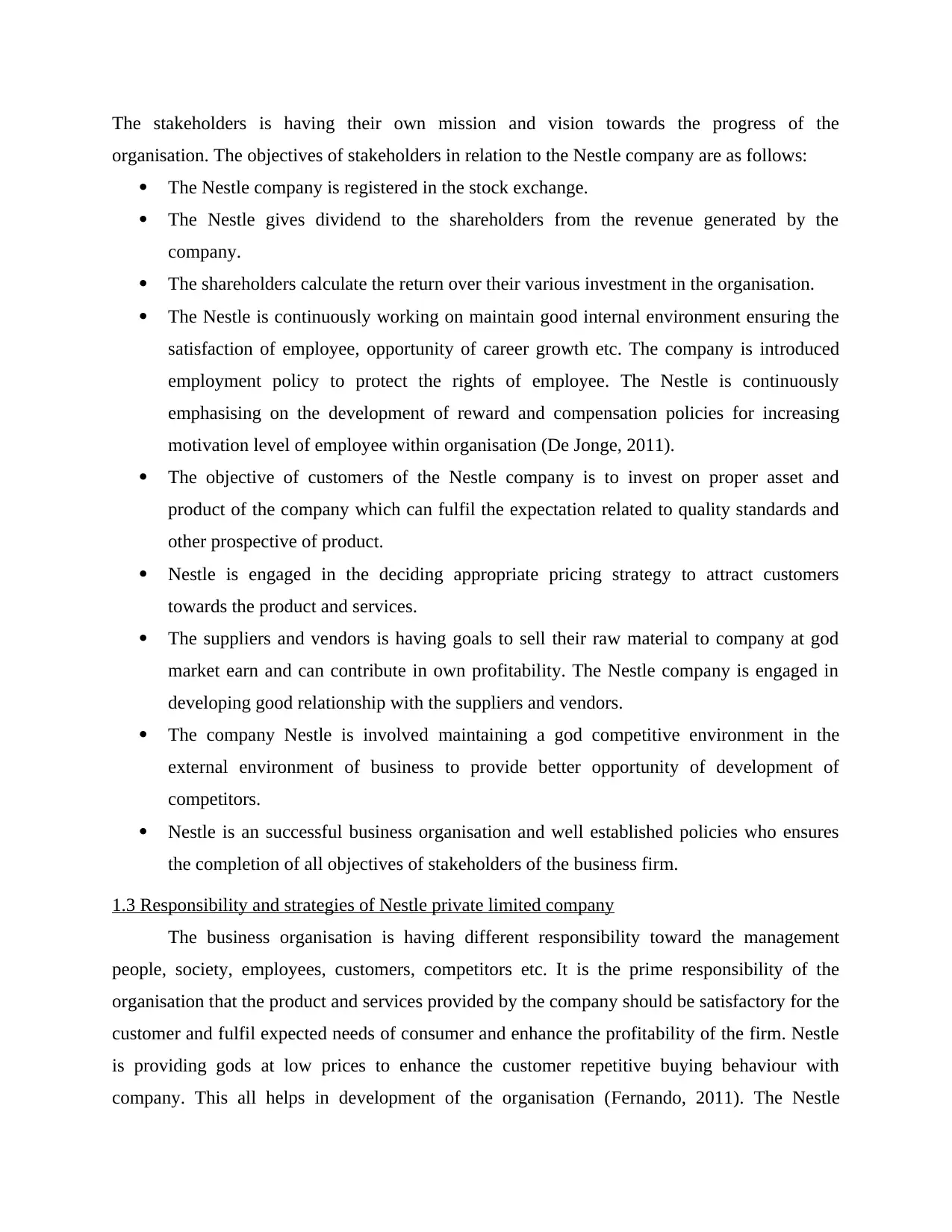
The stakeholders is having their own mission and vision towards the progress of the
organisation. The objectives of stakeholders in relation to the Nestle company are as follows:
The Nestle company is registered in the stock exchange.
The Nestle gives dividend to the shareholders from the revenue generated by the
company.
The shareholders calculate the return over their various investment in the organisation.
The Nestle is continuously working on maintain good internal environment ensuring the
satisfaction of employee, opportunity of career growth etc. The company is introduced
employment policy to protect the rights of employee. The Nestle is continuously
emphasising on the development of reward and compensation policies for increasing
motivation level of employee within organisation (De Jonge, 2011).
The objective of customers of the Nestle company is to invest on proper asset and
product of the company which can fulfil the expectation related to quality standards and
other prospective of product.
Nestle is engaged in the deciding appropriate pricing strategy to attract customers
towards the product and services.
The suppliers and vendors is having goals to sell their raw material to company at god
market earn and can contribute in own profitability. The Nestle company is engaged in
developing good relationship with the suppliers and vendors.
The company Nestle is involved maintaining a god competitive environment in the
external environment of business to provide better opportunity of development of
competitors.
Nestle is an successful business organisation and well established policies who ensures
the completion of all objectives of stakeholders of the business firm.
1.3 Responsibility and strategies of Nestle private limited company
The business organisation is having different responsibility toward the management
people, society, employees, customers, competitors etc. It is the prime responsibility of the
organisation that the product and services provided by the company should be satisfactory for the
customer and fulfil expected needs of consumer and enhance the profitability of the firm. Nestle
is providing gods at low prices to enhance the customer repetitive buying behaviour with
company. This all helps in development of the organisation (Fernando, 2011). The Nestle
organisation. The objectives of stakeholders in relation to the Nestle company are as follows:
The Nestle company is registered in the stock exchange.
The Nestle gives dividend to the shareholders from the revenue generated by the
company.
The shareholders calculate the return over their various investment in the organisation.
The Nestle is continuously working on maintain good internal environment ensuring the
satisfaction of employee, opportunity of career growth etc. The company is introduced
employment policy to protect the rights of employee. The Nestle is continuously
emphasising on the development of reward and compensation policies for increasing
motivation level of employee within organisation (De Jonge, 2011).
The objective of customers of the Nestle company is to invest on proper asset and
product of the company which can fulfil the expectation related to quality standards and
other prospective of product.
Nestle is engaged in the deciding appropriate pricing strategy to attract customers
towards the product and services.
The suppliers and vendors is having goals to sell their raw material to company at god
market earn and can contribute in own profitability. The Nestle company is engaged in
developing good relationship with the suppliers and vendors.
The company Nestle is involved maintaining a god competitive environment in the
external environment of business to provide better opportunity of development of
competitors.
Nestle is an successful business organisation and well established policies who ensures
the completion of all objectives of stakeholders of the business firm.
1.3 Responsibility and strategies of Nestle private limited company
The business organisation is having different responsibility toward the management
people, society, employees, customers, competitors etc. It is the prime responsibility of the
organisation that the product and services provided by the company should be satisfactory for the
customer and fulfil expected needs of consumer and enhance the profitability of the firm. Nestle
is providing gods at low prices to enhance the customer repetitive buying behaviour with
company. This all helps in development of the organisation (Fernando, 2011). The Nestle
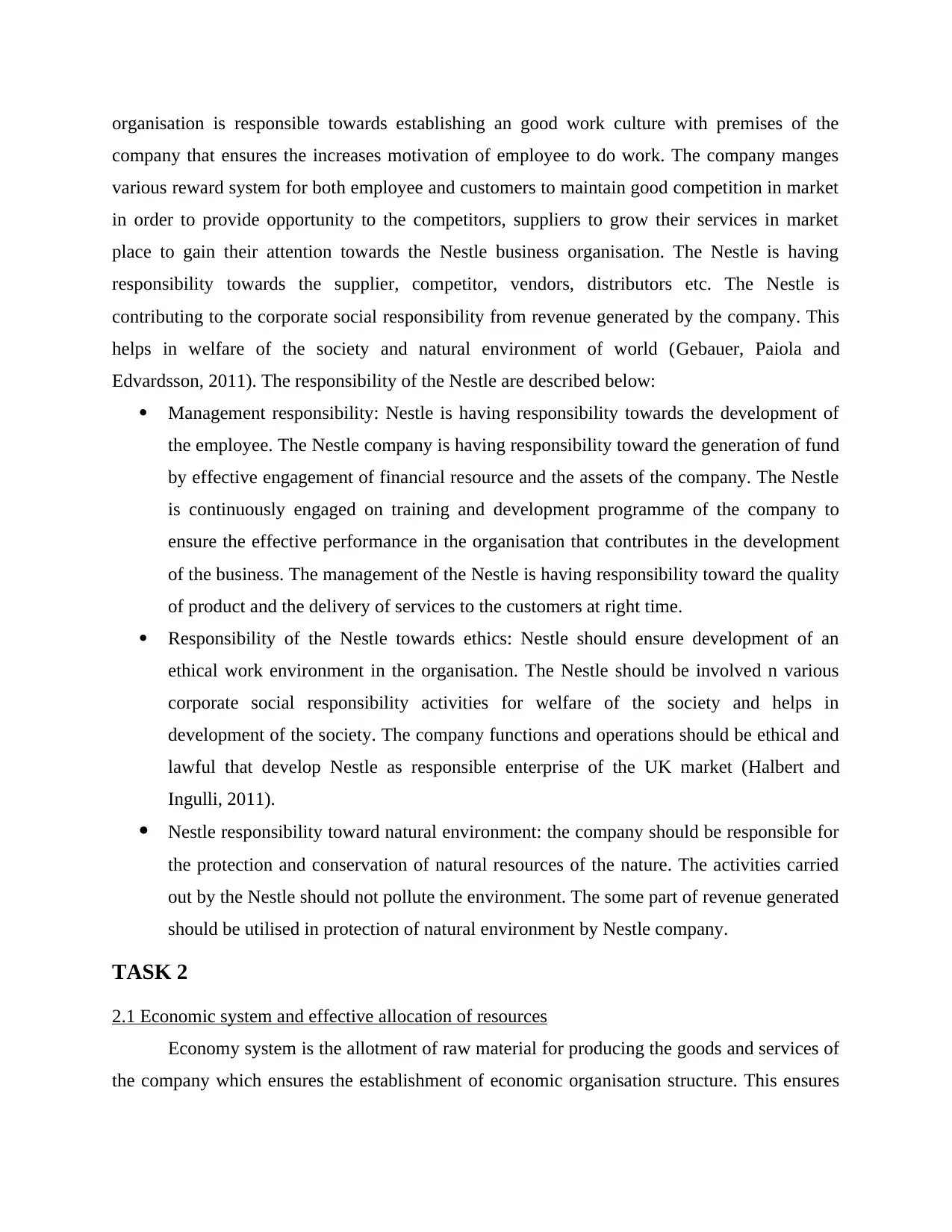
organisation is responsible towards establishing an good work culture with premises of the
company that ensures the increases motivation of employee to do work. The company manges
various reward system for both employee and customers to maintain good competition in market
in order to provide opportunity to the competitors, suppliers to grow their services in market
place to gain their attention towards the Nestle business organisation. The Nestle is having
responsibility towards the supplier, competitor, vendors, distributors etc. The Nestle is
contributing to the corporate social responsibility from revenue generated by the company. This
helps in welfare of the society and natural environment of world (Gebauer, Paiola and
Edvardsson, 2011). The responsibility of the Nestle are described below:
Management responsibility: Nestle is having responsibility towards the development of
the employee. The Nestle company is having responsibility toward the generation of fund
by effective engagement of financial resource and the assets of the company. The Nestle
is continuously engaged on training and development programme of the company to
ensure the effective performance in the organisation that contributes in the development
of the business. The management of the Nestle is having responsibility toward the quality
of product and the delivery of services to the customers at right time.
Responsibility of the Nestle towards ethics: Nestle should ensure development of an
ethical work environment in the organisation. The Nestle should be involved n various
corporate social responsibility activities for welfare of the society and helps in
development of the society. The company functions and operations should be ethical and
lawful that develop Nestle as responsible enterprise of the UK market (Halbert and
Ingulli, 2011).
Nestle responsibility toward natural environment: the company should be responsible for
the protection and conservation of natural resources of the nature. The activities carried
out by the Nestle should not pollute the environment. The some part of revenue generated
should be utilised in protection of natural environment by Nestle company.
TASK 2
2.1 Economic system and effective allocation of resources
Economy system is the allotment of raw material for producing the goods and services of
the company which ensures the establishment of economic organisation structure. This ensures
company that ensures the increases motivation of employee to do work. The company manges
various reward system for both employee and customers to maintain good competition in market
in order to provide opportunity to the competitors, suppliers to grow their services in market
place to gain their attention towards the Nestle business organisation. The Nestle is having
responsibility towards the supplier, competitor, vendors, distributors etc. The Nestle is
contributing to the corporate social responsibility from revenue generated by the company. This
helps in welfare of the society and natural environment of world (Gebauer, Paiola and
Edvardsson, 2011). The responsibility of the Nestle are described below:
Management responsibility: Nestle is having responsibility towards the development of
the employee. The Nestle company is having responsibility toward the generation of fund
by effective engagement of financial resource and the assets of the company. The Nestle
is continuously engaged on training and development programme of the company to
ensure the effective performance in the organisation that contributes in the development
of the business. The management of the Nestle is having responsibility toward the quality
of product and the delivery of services to the customers at right time.
Responsibility of the Nestle towards ethics: Nestle should ensure development of an
ethical work environment in the organisation. The Nestle should be involved n various
corporate social responsibility activities for welfare of the society and helps in
development of the society. The company functions and operations should be ethical and
lawful that develop Nestle as responsible enterprise of the UK market (Halbert and
Ingulli, 2011).
Nestle responsibility toward natural environment: the company should be responsible for
the protection and conservation of natural resources of the nature. The activities carried
out by the Nestle should not pollute the environment. The some part of revenue generated
should be utilised in protection of natural environment by Nestle company.
TASK 2
2.1 Economic system and effective allocation of resources
Economy system is the allotment of raw material for producing the goods and services of
the company which ensures the establishment of economic organisation structure. This ensures
⊘ This is a preview!⊘
Do you want full access?
Subscribe today to unlock all pages.

Trusted by 1+ million students worldwide
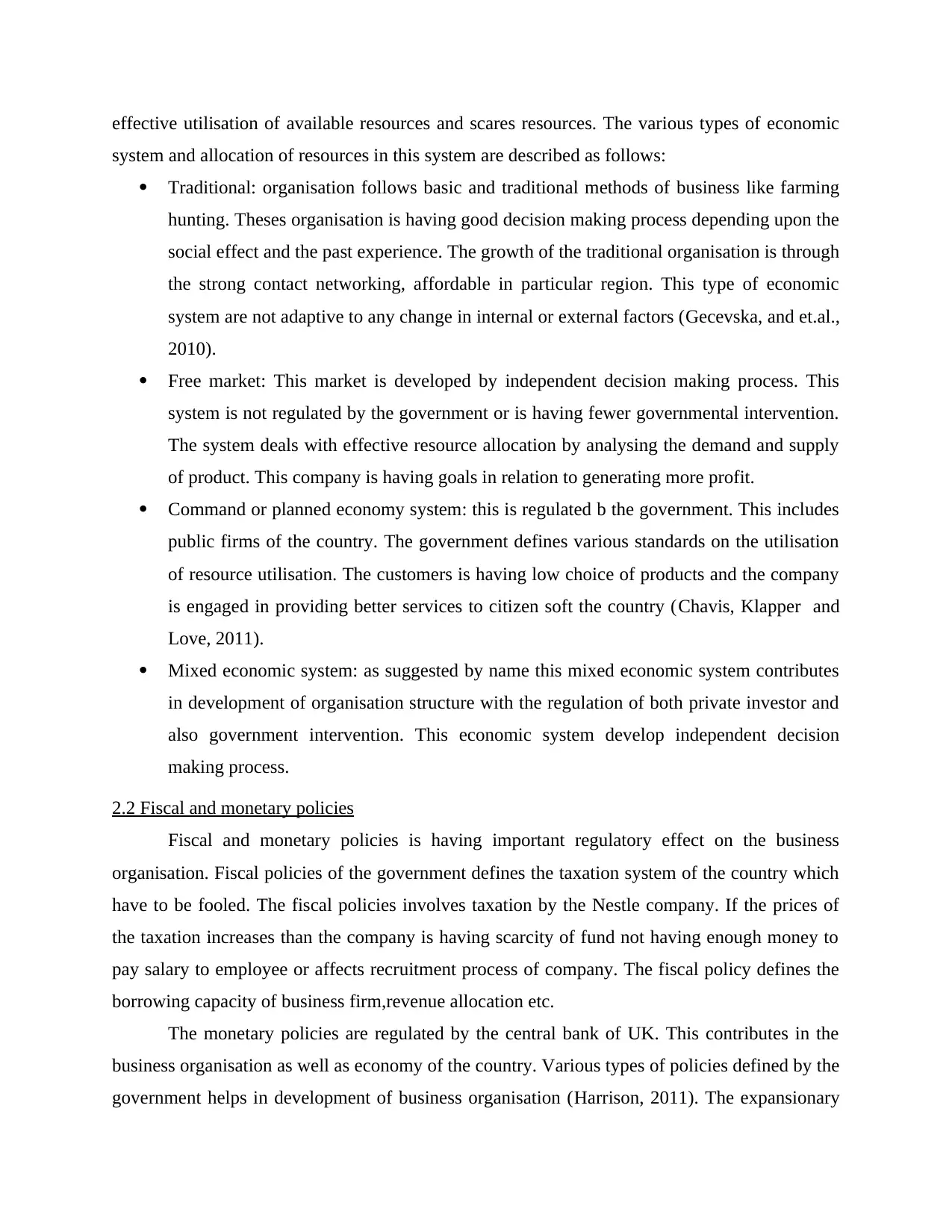
effective utilisation of available resources and scares resources. The various types of economic
system and allocation of resources in this system are described as follows:
Traditional: organisation follows basic and traditional methods of business like farming
hunting. Theses organisation is having good decision making process depending upon the
social effect and the past experience. The growth of the traditional organisation is through
the strong contact networking, affordable in particular region. This type of economic
system are not adaptive to any change in internal or external factors (Gecevska, and et.al.,
2010).
Free market: This market is developed by independent decision making process. This
system is not regulated by the government or is having fewer governmental intervention.
The system deals with effective resource allocation by analysing the demand and supply
of product. This company is having goals in relation to generating more profit.
Command or planned economy system: this is regulated b the government. This includes
public firms of the country. The government defines various standards on the utilisation
of resource utilisation. The customers is having low choice of products and the company
is engaged in providing better services to citizen soft the country (Chavis, Klapper and
Love, 2011).
Mixed economic system: as suggested by name this mixed economic system contributes
in development of organisation structure with the regulation of both private investor and
also government intervention. This economic system develop independent decision
making process.
2.2 Fiscal and monetary policies
Fiscal and monetary policies is having important regulatory effect on the business
organisation. Fiscal policies of the government defines the taxation system of the country which
have to be fooled. The fiscal policies involves taxation by the Nestle company. If the prices of
the taxation increases than the company is having scarcity of fund not having enough money to
pay salary to employee or affects recruitment process of company. The fiscal policy defines the
borrowing capacity of business firm,revenue allocation etc.
The monetary policies are regulated by the central bank of UK. This contributes in the
business organisation as well as economy of the country. Various types of policies defined by the
government helps in development of business organisation (Harrison, 2011). The expansionary
system and allocation of resources in this system are described as follows:
Traditional: organisation follows basic and traditional methods of business like farming
hunting. Theses organisation is having good decision making process depending upon the
social effect and the past experience. The growth of the traditional organisation is through
the strong contact networking, affordable in particular region. This type of economic
system are not adaptive to any change in internal or external factors (Gecevska, and et.al.,
2010).
Free market: This market is developed by independent decision making process. This
system is not regulated by the government or is having fewer governmental intervention.
The system deals with effective resource allocation by analysing the demand and supply
of product. This company is having goals in relation to generating more profit.
Command or planned economy system: this is regulated b the government. This includes
public firms of the country. The government defines various standards on the utilisation
of resource utilisation. The customers is having low choice of products and the company
is engaged in providing better services to citizen soft the country (Chavis, Klapper and
Love, 2011).
Mixed economic system: as suggested by name this mixed economic system contributes
in development of organisation structure with the regulation of both private investor and
also government intervention. This economic system develop independent decision
making process.
2.2 Fiscal and monetary policies
Fiscal and monetary policies is having important regulatory effect on the business
organisation. Fiscal policies of the government defines the taxation system of the country which
have to be fooled. The fiscal policies involves taxation by the Nestle company. If the prices of
the taxation increases than the company is having scarcity of fund not having enough money to
pay salary to employee or affects recruitment process of company. The fiscal policy defines the
borrowing capacity of business firm,revenue allocation etc.
The monetary policies are regulated by the central bank of UK. This contributes in the
business organisation as well as economy of the country. Various types of policies defined by the
government helps in development of business organisation (Harrison, 2011). The expansionary
Paraphrase This Document
Need a fresh take? Get an instant paraphrase of this document with our AI Paraphraser
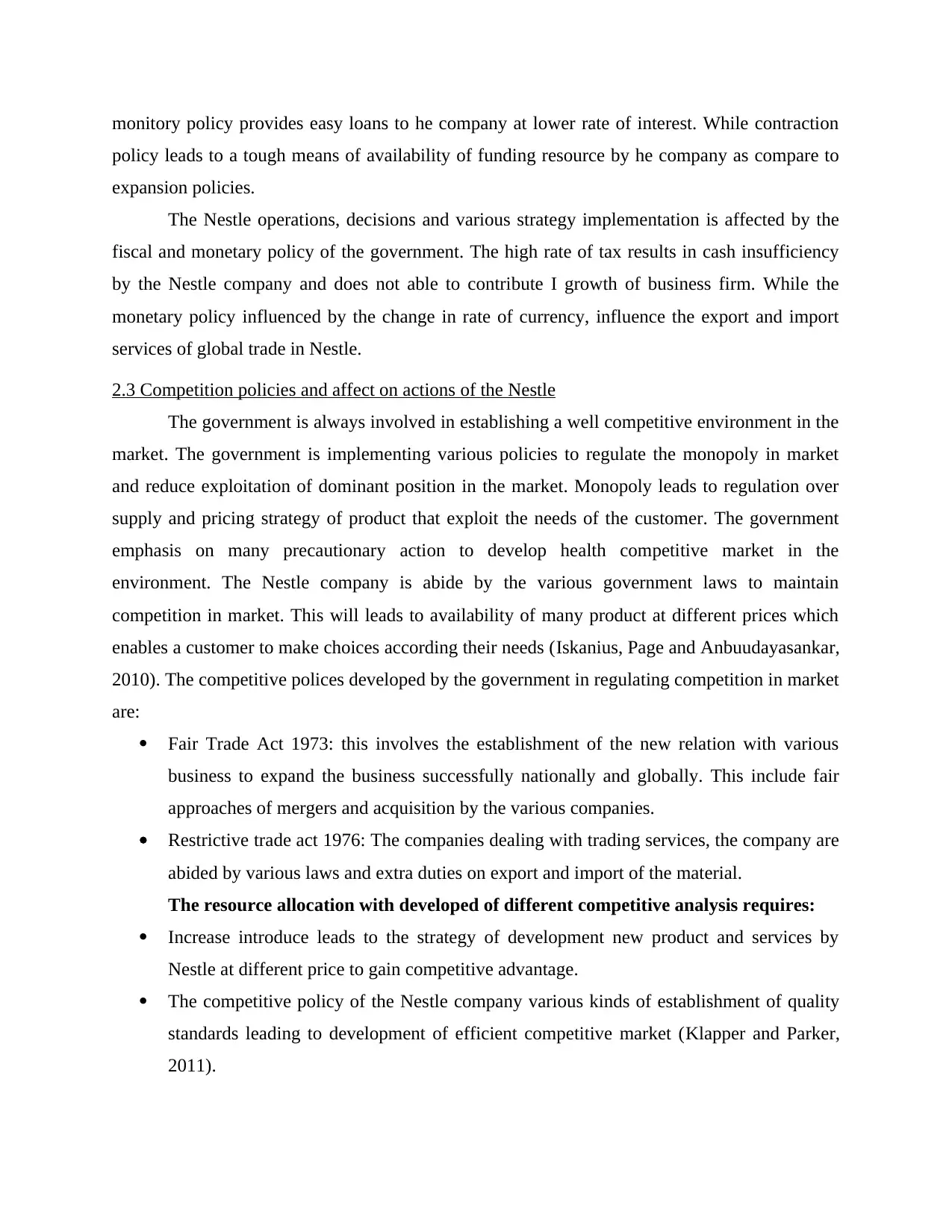
monitory policy provides easy loans to he company at lower rate of interest. While contraction
policy leads to a tough means of availability of funding resource by he company as compare to
expansion policies.
The Nestle operations, decisions and various strategy implementation is affected by the
fiscal and monetary policy of the government. The high rate of tax results in cash insufficiency
by the Nestle company and does not able to contribute I growth of business firm. While the
monetary policy influenced by the change in rate of currency, influence the export and import
services of global trade in Nestle.
2.3 Competition policies and affect on actions of the Nestle
The government is always involved in establishing a well competitive environment in the
market. The government is implementing various policies to regulate the monopoly in market
and reduce exploitation of dominant position in the market. Monopoly leads to regulation over
supply and pricing strategy of product that exploit the needs of the customer. The government
emphasis on many precautionary action to develop health competitive market in the
environment. The Nestle company is abide by the various government laws to maintain
competition in market. This will leads to availability of many product at different prices which
enables a customer to make choices according their needs (Iskanius, Page and Anbuudayasankar,
2010). The competitive polices developed by the government in regulating competition in market
are:
Fair Trade Act 1973: this involves the establishment of the new relation with various
business to expand the business successfully nationally and globally. This include fair
approaches of mergers and acquisition by the various companies.
Restrictive trade act 1976: The companies dealing with trading services, the company are
abided by various laws and extra duties on export and import of the material.
The resource allocation with developed of different competitive analysis requires:
Increase introduce leads to the strategy of development new product and services by
Nestle at different price to gain competitive advantage.
The competitive policy of the Nestle company various kinds of establishment of quality
standards leading to development of efficient competitive market (Klapper and Parker,
2011).
policy leads to a tough means of availability of funding resource by he company as compare to
expansion policies.
The Nestle operations, decisions and various strategy implementation is affected by the
fiscal and monetary policy of the government. The high rate of tax results in cash insufficiency
by the Nestle company and does not able to contribute I growth of business firm. While the
monetary policy influenced by the change in rate of currency, influence the export and import
services of global trade in Nestle.
2.3 Competition policies and affect on actions of the Nestle
The government is always involved in establishing a well competitive environment in the
market. The government is implementing various policies to regulate the monopoly in market
and reduce exploitation of dominant position in the market. Monopoly leads to regulation over
supply and pricing strategy of product that exploit the needs of the customer. The government
emphasis on many precautionary action to develop health competitive market in the
environment. The Nestle company is abide by the various government laws to maintain
competition in market. This will leads to availability of many product at different prices which
enables a customer to make choices according their needs (Iskanius, Page and Anbuudayasankar,
2010). The competitive polices developed by the government in regulating competition in market
are:
Fair Trade Act 1973: this involves the establishment of the new relation with various
business to expand the business successfully nationally and globally. This include fair
approaches of mergers and acquisition by the various companies.
Restrictive trade act 1976: The companies dealing with trading services, the company are
abided by various laws and extra duties on export and import of the material.
The resource allocation with developed of different competitive analysis requires:
Increase introduce leads to the strategy of development new product and services by
Nestle at different price to gain competitive advantage.
The competitive policy of the Nestle company various kinds of establishment of quality
standards leading to development of efficient competitive market (Klapper and Parker,
2011).
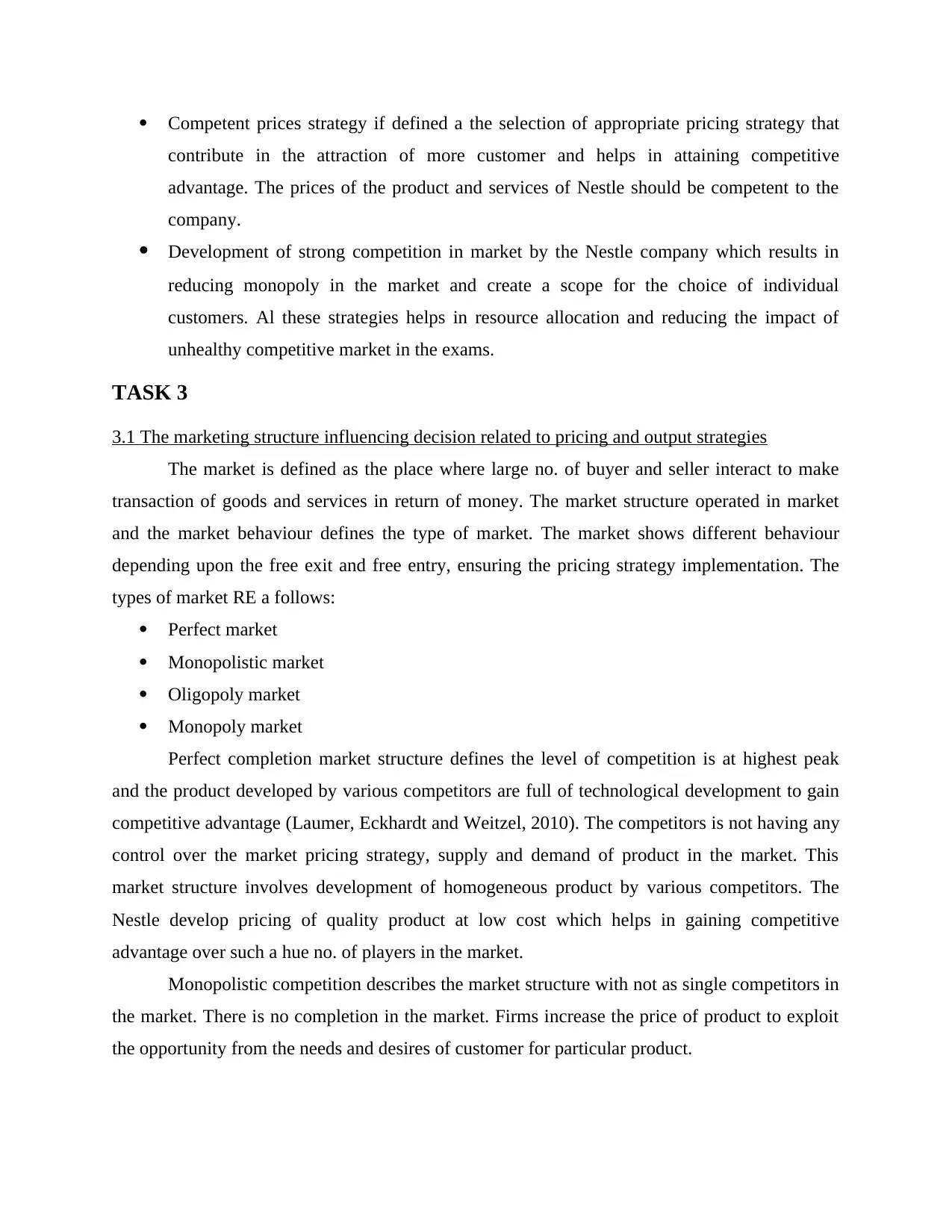
Competent prices strategy if defined a the selection of appropriate pricing strategy that
contribute in the attraction of more customer and helps in attaining competitive
advantage. The prices of the product and services of Nestle should be competent to the
company.
Development of strong competition in market by the Nestle company which results in
reducing monopoly in the market and create a scope for the choice of individual
customers. Al these strategies helps in resource allocation and reducing the impact of
unhealthy competitive market in the exams.
TASK 3
3.1 The marketing structure influencing decision related to pricing and output strategies
The market is defined as the place where large no. of buyer and seller interact to make
transaction of goods and services in return of money. The market structure operated in market
and the market behaviour defines the type of market. The market shows different behaviour
depending upon the free exit and free entry, ensuring the pricing strategy implementation. The
types of market RE a follows:
Perfect market
Monopolistic market
Oligopoly market
Monopoly market
Perfect completion market structure defines the level of competition is at highest peak
and the product developed by various competitors are full of technological development to gain
competitive advantage (Laumer, Eckhardt and Weitzel, 2010). The competitors is not having any
control over the market pricing strategy, supply and demand of product in the market. This
market structure involves development of homogeneous product by various competitors. The
Nestle develop pricing of quality product at low cost which helps in gaining competitive
advantage over such a hue no. of players in the market.
Monopolistic competition describes the market structure with not as single competitors in
the market. There is no completion in the market. Firms increase the price of product to exploit
the opportunity from the needs and desires of customer for particular product.
contribute in the attraction of more customer and helps in attaining competitive
advantage. The prices of the product and services of Nestle should be competent to the
company.
Development of strong competition in market by the Nestle company which results in
reducing monopoly in the market and create a scope for the choice of individual
customers. Al these strategies helps in resource allocation and reducing the impact of
unhealthy competitive market in the exams.
TASK 3
3.1 The marketing structure influencing decision related to pricing and output strategies
The market is defined as the place where large no. of buyer and seller interact to make
transaction of goods and services in return of money. The market structure operated in market
and the market behaviour defines the type of market. The market shows different behaviour
depending upon the free exit and free entry, ensuring the pricing strategy implementation. The
types of market RE a follows:
Perfect market
Monopolistic market
Oligopoly market
Monopoly market
Perfect completion market structure defines the level of competition is at highest peak
and the product developed by various competitors are full of technological development to gain
competitive advantage (Laumer, Eckhardt and Weitzel, 2010). The competitors is not having any
control over the market pricing strategy, supply and demand of product in the market. This
market structure involves development of homogeneous product by various competitors. The
Nestle develop pricing of quality product at low cost which helps in gaining competitive
advantage over such a hue no. of players in the market.
Monopolistic competition describes the market structure with not as single competitors in
the market. There is no completion in the market. Firms increase the price of product to exploit
the opportunity from the needs and desires of customer for particular product.
⊘ This is a preview!⊘
Do you want full access?
Subscribe today to unlock all pages.

Trusted by 1+ million students worldwide
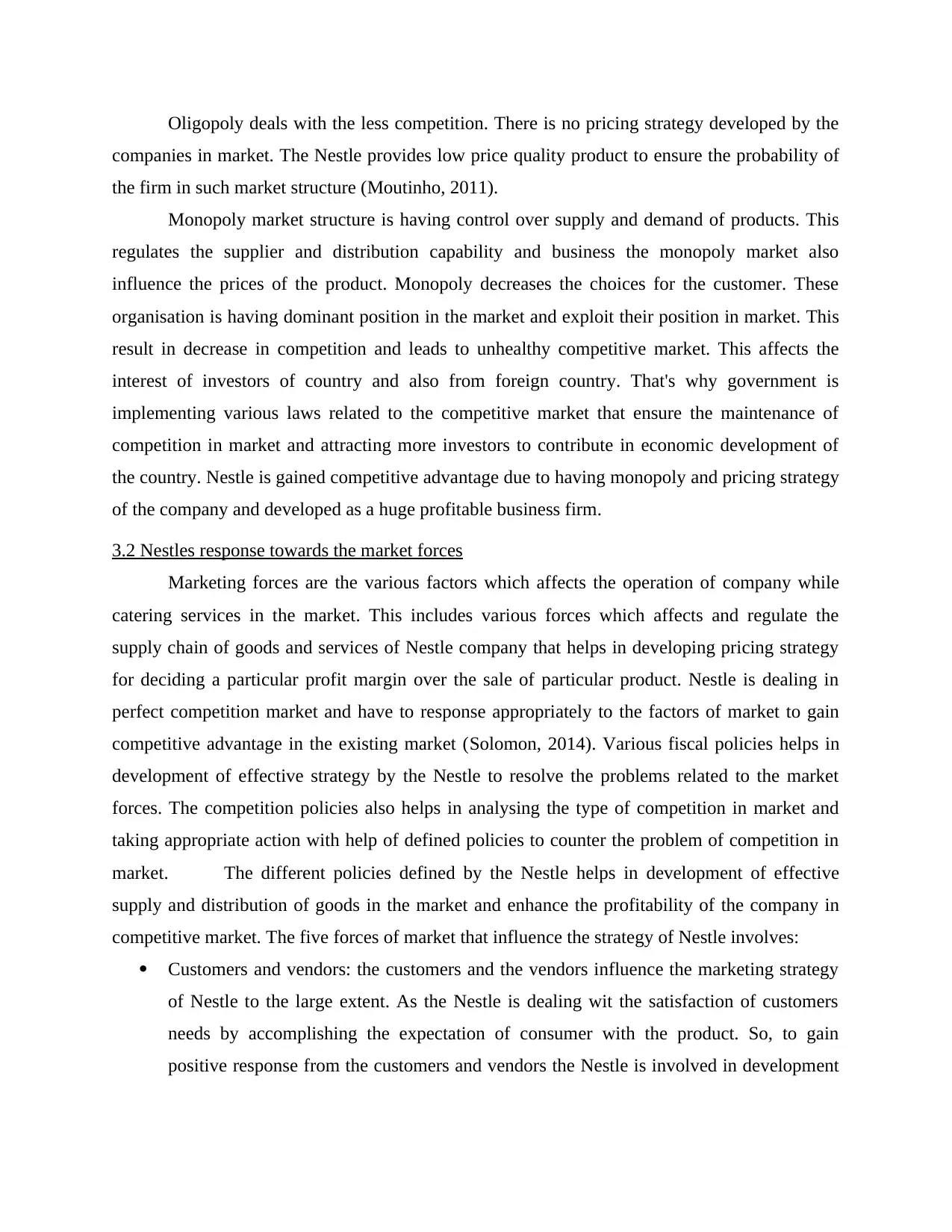
Oligopoly deals with the less competition. There is no pricing strategy developed by the
companies in market. The Nestle provides low price quality product to ensure the probability of
the firm in such market structure (Moutinho, 2011).
Monopoly market structure is having control over supply and demand of products. This
regulates the supplier and distribution capability and business the monopoly market also
influence the prices of the product. Monopoly decreases the choices for the customer. These
organisation is having dominant position in the market and exploit their position in market. This
result in decrease in competition and leads to unhealthy competitive market. This affects the
interest of investors of country and also from foreign country. That's why government is
implementing various laws related to the competitive market that ensure the maintenance of
competition in market and attracting more investors to contribute in economic development of
the country. Nestle is gained competitive advantage due to having monopoly and pricing strategy
of the company and developed as a huge profitable business firm.
3.2 Nestles response towards the market forces
Marketing forces are the various factors which affects the operation of company while
catering services in the market. This includes various forces which affects and regulate the
supply chain of goods and services of Nestle company that helps in developing pricing strategy
for deciding a particular profit margin over the sale of particular product. Nestle is dealing in
perfect competition market and have to response appropriately to the factors of market to gain
competitive advantage in the existing market (Solomon, 2014). Various fiscal policies helps in
development of effective strategy by the Nestle to resolve the problems related to the market
forces. The competition policies also helps in analysing the type of competition in market and
taking appropriate action with help of defined policies to counter the problem of competition in
market. The different policies defined by the Nestle helps in development of effective
supply and distribution of goods in the market and enhance the profitability of the company in
competitive market. The five forces of market that influence the strategy of Nestle involves:
Customers and vendors: the customers and the vendors influence the marketing strategy
of Nestle to the large extent. As the Nestle is dealing wit the satisfaction of customers
needs by accomplishing the expectation of consumer with the product. So, to gain
positive response from the customers and vendors the Nestle is involved in development
companies in market. The Nestle provides low price quality product to ensure the probability of
the firm in such market structure (Moutinho, 2011).
Monopoly market structure is having control over supply and demand of products. This
regulates the supplier and distribution capability and business the monopoly market also
influence the prices of the product. Monopoly decreases the choices for the customer. These
organisation is having dominant position in the market and exploit their position in market. This
result in decrease in competition and leads to unhealthy competitive market. This affects the
interest of investors of country and also from foreign country. That's why government is
implementing various laws related to the competitive market that ensure the maintenance of
competition in market and attracting more investors to contribute in economic development of
the country. Nestle is gained competitive advantage due to having monopoly and pricing strategy
of the company and developed as a huge profitable business firm.
3.2 Nestles response towards the market forces
Marketing forces are the various factors which affects the operation of company while
catering services in the market. This includes various forces which affects and regulate the
supply chain of goods and services of Nestle company that helps in developing pricing strategy
for deciding a particular profit margin over the sale of particular product. Nestle is dealing in
perfect competition market and have to response appropriately to the factors of market to gain
competitive advantage in the existing market (Solomon, 2014). Various fiscal policies helps in
development of effective strategy by the Nestle to resolve the problems related to the market
forces. The competition policies also helps in analysing the type of competition in market and
taking appropriate action with help of defined policies to counter the problem of competition in
market. The different policies defined by the Nestle helps in development of effective
supply and distribution of goods in the market and enhance the profitability of the company in
competitive market. The five forces of market that influence the strategy of Nestle involves:
Customers and vendors: the customers and the vendors influence the marketing strategy
of Nestle to the large extent. As the Nestle is dealing wit the satisfaction of customers
needs by accomplishing the expectation of consumer with the product. So, to gain
positive response from the customers and vendors the Nestle is involved in development
Paraphrase This Document
Need a fresh take? Get an instant paraphrase of this document with our AI Paraphraser
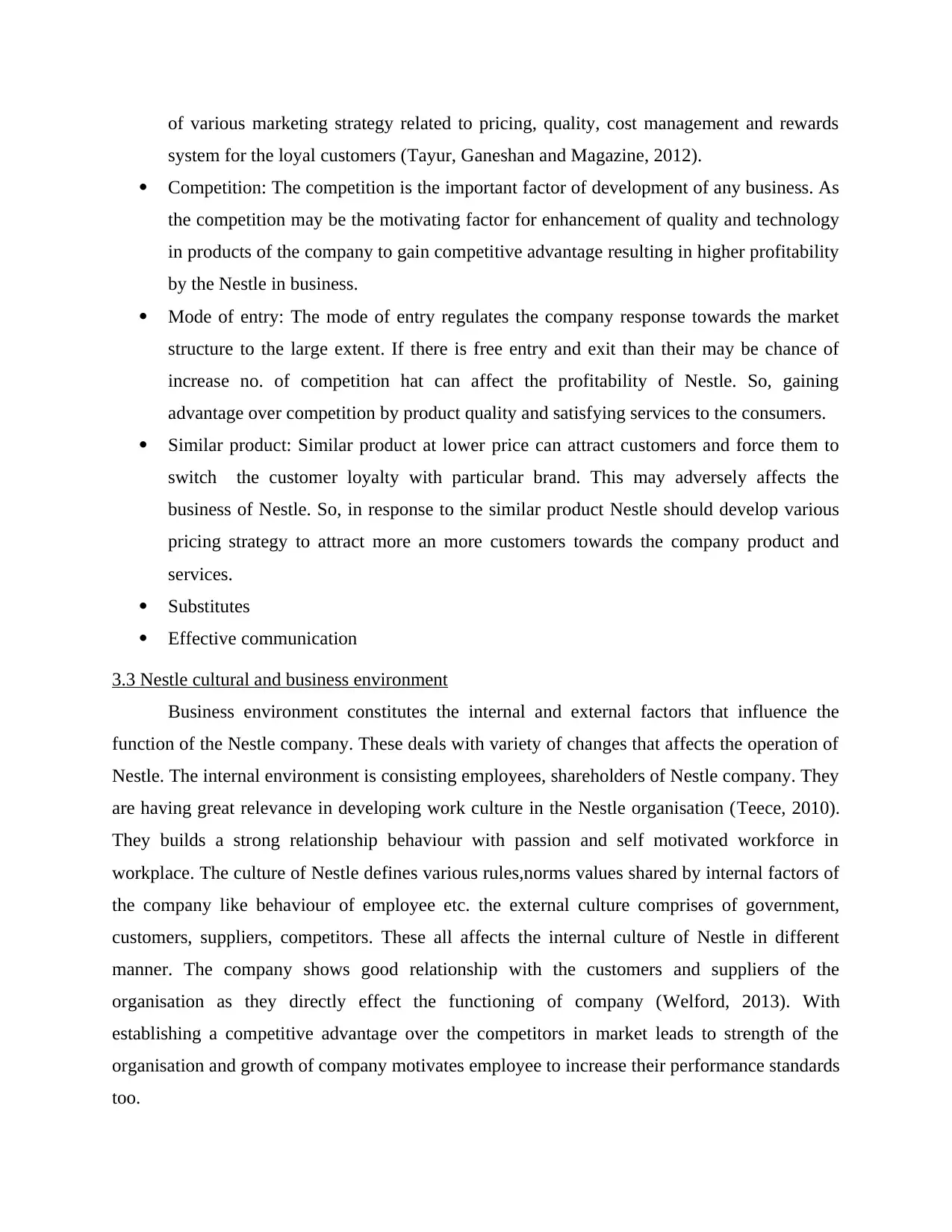
of various marketing strategy related to pricing, quality, cost management and rewards
system for the loyal customers (Tayur, Ganeshan and Magazine, 2012).
Competition: The competition is the important factor of development of any business. As
the competition may be the motivating factor for enhancement of quality and technology
in products of the company to gain competitive advantage resulting in higher profitability
by the Nestle in business.
Mode of entry: The mode of entry regulates the company response towards the market
structure to the large extent. If there is free entry and exit than their may be chance of
increase no. of competition hat can affect the profitability of Nestle. So, gaining
advantage over competition by product quality and satisfying services to the consumers.
Similar product: Similar product at lower price can attract customers and force them to
switch the customer loyalty with particular brand. This may adversely affects the
business of Nestle. So, in response to the similar product Nestle should develop various
pricing strategy to attract more an more customers towards the company product and
services.
Substitutes
Effective communication
3.3 Nestle cultural and business environment
Business environment constitutes the internal and external factors that influence the
function of the Nestle company. These deals with variety of changes that affects the operation of
Nestle. The internal environment is consisting employees, shareholders of Nestle company. They
are having great relevance in developing work culture in the Nestle organisation (Teece, 2010).
They builds a strong relationship behaviour with passion and self motivated workforce in
workplace. The culture of Nestle defines various rules,norms values shared by internal factors of
the company like behaviour of employee etc. the external culture comprises of government,
customers, suppliers, competitors. These all affects the internal culture of Nestle in different
manner. The company shows good relationship with the customers and suppliers of the
organisation as they directly effect the functioning of company (Welford, 2013). With
establishing a competitive advantage over the competitors in market leads to strength of the
organisation and growth of company motivates employee to increase their performance standards
too.
system for the loyal customers (Tayur, Ganeshan and Magazine, 2012).
Competition: The competition is the important factor of development of any business. As
the competition may be the motivating factor for enhancement of quality and technology
in products of the company to gain competitive advantage resulting in higher profitability
by the Nestle in business.
Mode of entry: The mode of entry regulates the company response towards the market
structure to the large extent. If there is free entry and exit than their may be chance of
increase no. of competition hat can affect the profitability of Nestle. So, gaining
advantage over competition by product quality and satisfying services to the consumers.
Similar product: Similar product at lower price can attract customers and force them to
switch the customer loyalty with particular brand. This may adversely affects the
business of Nestle. So, in response to the similar product Nestle should develop various
pricing strategy to attract more an more customers towards the company product and
services.
Substitutes
Effective communication
3.3 Nestle cultural and business environment
Business environment constitutes the internal and external factors that influence the
function of the Nestle company. These deals with variety of changes that affects the operation of
Nestle. The internal environment is consisting employees, shareholders of Nestle company. They
are having great relevance in developing work culture in the Nestle organisation (Teece, 2010).
They builds a strong relationship behaviour with passion and self motivated workforce in
workplace. The culture of Nestle defines various rules,norms values shared by internal factors of
the company like behaviour of employee etc. the external culture comprises of government,
customers, suppliers, competitors. These all affects the internal culture of Nestle in different
manner. The company shows good relationship with the customers and suppliers of the
organisation as they directly effect the functioning of company (Welford, 2013). With
establishing a competitive advantage over the competitors in market leads to strength of the
organisation and growth of company motivates employee to increase their performance standards
too.
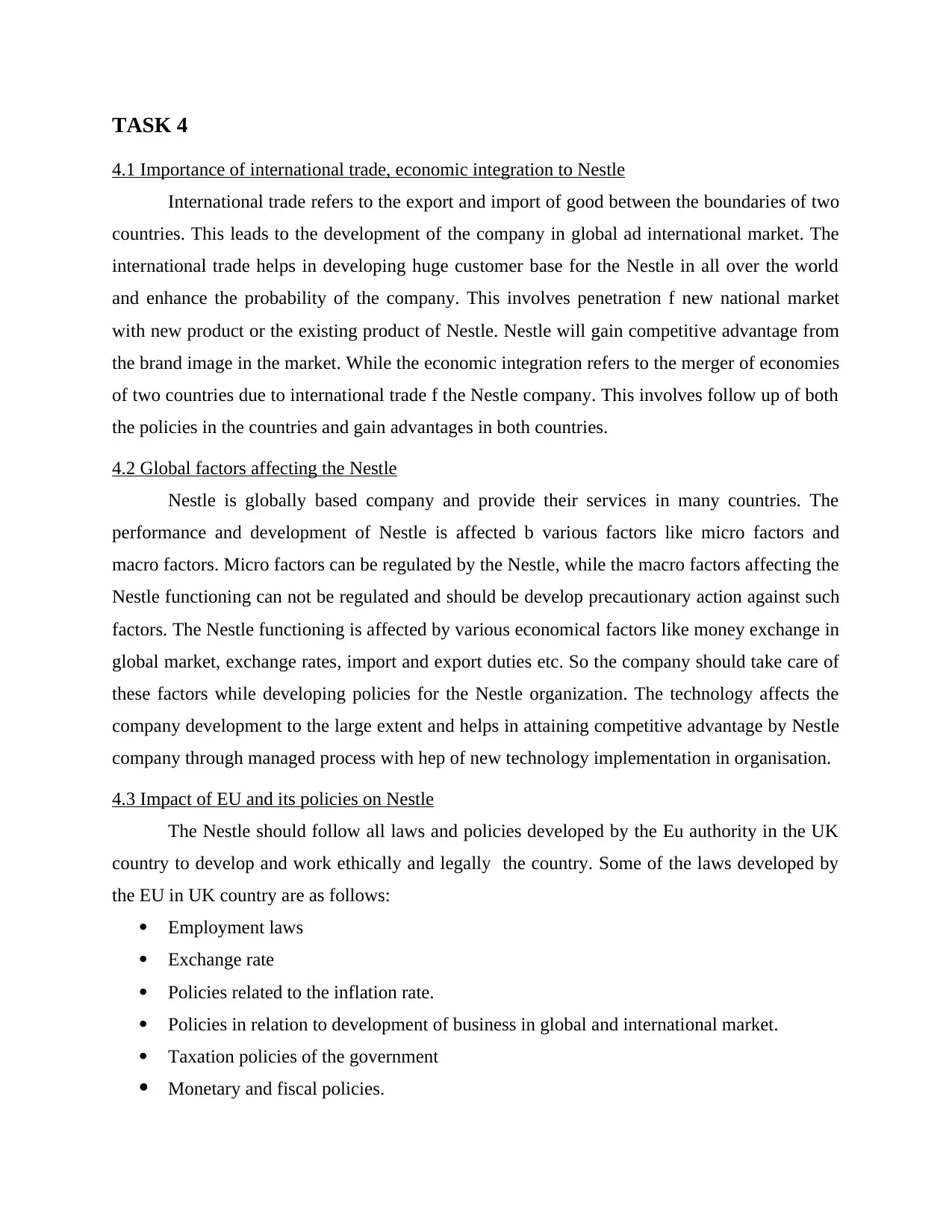
TASK 4
4.1 Importance of international trade, economic integration to Nestle
International trade refers to the export and import of good between the boundaries of two
countries. This leads to the development of the company in global ad international market. The
international trade helps in developing huge customer base for the Nestle in all over the world
and enhance the probability of the company. This involves penetration f new national market
with new product or the existing product of Nestle. Nestle will gain competitive advantage from
the brand image in the market. While the economic integration refers to the merger of economies
of two countries due to international trade f the Nestle company. This involves follow up of both
the policies in the countries and gain advantages in both countries.
4.2 Global factors affecting the Nestle
Nestle is globally based company and provide their services in many countries. The
performance and development of Nestle is affected b various factors like micro factors and
macro factors. Micro factors can be regulated by the Nestle, while the macro factors affecting the
Nestle functioning can not be regulated and should be develop precautionary action against such
factors. The Nestle functioning is affected by various economical factors like money exchange in
global market, exchange rates, import and export duties etc. So the company should take care of
these factors while developing policies for the Nestle organization. The technology affects the
company development to the large extent and helps in attaining competitive advantage by Nestle
company through managed process with hep of new technology implementation in organisation.
4.3 Impact of EU and its policies on Nestle
The Nestle should follow all laws and policies developed by the Eu authority in the UK
country to develop and work ethically and legally the country. Some of the laws developed by
the EU in UK country are as follows:
Employment laws
Exchange rate
Policies related to the inflation rate.
Policies in relation to development of business in global and international market.
Taxation policies of the government
Monetary and fiscal policies.
4.1 Importance of international trade, economic integration to Nestle
International trade refers to the export and import of good between the boundaries of two
countries. This leads to the development of the company in global ad international market. The
international trade helps in developing huge customer base for the Nestle in all over the world
and enhance the probability of the company. This involves penetration f new national market
with new product or the existing product of Nestle. Nestle will gain competitive advantage from
the brand image in the market. While the economic integration refers to the merger of economies
of two countries due to international trade f the Nestle company. This involves follow up of both
the policies in the countries and gain advantages in both countries.
4.2 Global factors affecting the Nestle
Nestle is globally based company and provide their services in many countries. The
performance and development of Nestle is affected b various factors like micro factors and
macro factors. Micro factors can be regulated by the Nestle, while the macro factors affecting the
Nestle functioning can not be regulated and should be develop precautionary action against such
factors. The Nestle functioning is affected by various economical factors like money exchange in
global market, exchange rates, import and export duties etc. So the company should take care of
these factors while developing policies for the Nestle organization. The technology affects the
company development to the large extent and helps in attaining competitive advantage by Nestle
company through managed process with hep of new technology implementation in organisation.
4.3 Impact of EU and its policies on Nestle
The Nestle should follow all laws and policies developed by the Eu authority in the UK
country to develop and work ethically and legally the country. Some of the laws developed by
the EU in UK country are as follows:
Employment laws
Exchange rate
Policies related to the inflation rate.
Policies in relation to development of business in global and international market.
Taxation policies of the government
Monetary and fiscal policies.
⊘ This is a preview!⊘
Do you want full access?
Subscribe today to unlock all pages.

Trusted by 1+ million students worldwide
1 out of 14
Related Documents
Your All-in-One AI-Powered Toolkit for Academic Success.
+13062052269
info@desklib.com
Available 24*7 on WhatsApp / Email
![[object Object]](/_next/static/media/star-bottom.7253800d.svg)
Unlock your academic potential
Copyright © 2020–2025 A2Z Services. All Rights Reserved. Developed and managed by ZUCOL.





